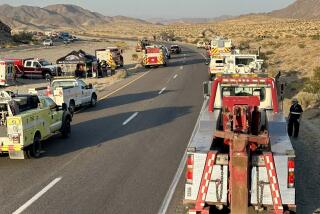New Lanes Will Help I-15 Pick Up Speed
- Share via
The voice from above--belonging to a professional traffic watcher in a helicopter--crackles on the car stereo and describes the morning scenario.
“There’s heavy traffic southbound on 15 coming out of Rancho Bernardo into Mira Mesa,” the voice says. “It’s bumper to bumper.”
It is the nightmarish reality San Diegans living in inland North County face daily as their cars inch along Interstate 15 toward downtown. What’s worse, commuters know that at the end of the day they will face a similar fate on the trip home.
But starting Thursday, state transportation officials promise commuters a way to combat the plague that afflicts the highways of Los Angeles and Orange counties.
A $31.4-million automated express-lane project--the first of its kind in the state--is expected to shuttle car poolers and buses through the most-congested sections of I-15 during peak commuting hours, said Jim Linthicum, a senior Caltrans engineer.
Electronic signboards, air-pressurized “delineators” and steel gates will guide traffic onto the two-lane, eight-mile stretch running from North City Parkway to the junction of California 163 and I-15.
The lanes are reversible--unlike standard freeway lanes that allow traffic to flow only in one direction, vehicles will travel in opposite directions on the same lanes at different peak-driving times. They were designed to ease the rush-hour crunch and convincingly sell commuters on the benefits of car pooling, Linthicum said.
The express lanes, which will operate southbound between 6 a.m. and 9 a.m. and northbound between 3 p.m. and 6 p.m., will allow only car pools with two or more occupants, plus buses, van pools and motorcycles, Linthicum said. They will be closed the rest of the day. On Thursday, the lanes will be open northbound only.
“Five out of six people still drive solo,” said Jim Larson, a Caltrans spokesman at a recent transportation forum. “But those people are going to start seeing other people who car pool go zooming by on the express lanes as they sit in traffic. That may change their attitude about car pooling.”
Once in operation, the express lanes are expected to reduce car volume by 10% to 15% on I-15, fast becoming one of the most-congested freeways in the county. According to Caltrans statistics, the number of cars has tripled in the last decade and has been increasing 11% annually the past two years. Between 140,000 and 200,000 cars use I-15 daily, statistics show.
The I-15 median that straddles the north and south bound lanes serves as the base for the two express lanes, which will funnel traffic in one direction--both lanes will allow cars to travel only southbound in the morning hours, and then reverse directions for the evening rush hour.
The express lanes are separated from the rest of I-15 by concrete walls that have special openings--four, 12-foot-wide sections for emergency vehicles, and five slots for California Highway Patrol motorcycles--to allow access in case of emergencies or accidents. The CHP will also be patrolling the express lanes to catch car-pool violators.
The greatest concern for transportation planners is the fear of an errant driver trying to enter the express lanes against the flow of traffic.
“The fact that these lanes are reversible is what makes this so unique,” Linthicum said. “We have two entrances (drawing traffic from opposite directions) to the same road. They’ll be going north and south on the same lanes (at different times). Obviously, that also creates our greatest fear.”
Guarding Against Error
State engineers have taken great pains, Linthicum said, to prevent the worst-case scenario--a car incorrectly entering the express lane and heading into uncoming traffic.
“We have more safeguards built into this thing than you can possibly imagine,” said Linthicum, referring to the express lanes’ “four lines of defense”: electronic signs, two rows of delineators and a steel gate.
“Our first line of defense are the signs,” Linthicum said. The electronic signs will display a variety of messages that will inform commuters when the express lanes are open or closed, provide commuters directions to enter the lanes and tell commuters the distance to the entrance.
“Let’s say for example, the driver fails to see the signs and tries to go onto the express lanes when they are closed,” Linthicum said.
Under such circumstances, the driver will encounter several rows of “pop up delineators” at the beginning of the closed express-lane ramp, Linthicum said. The air-pressure controlled delineators--cylindrical rubber tubes that serve as traffic cones--surface from the road when a ramp is closed, and withdraw when a ramp opens.
“By the time a driver hits the delineators, he should have a good sense he’s going the wrong way,” Linthicum said. “But if he continues to proceed, he’ll eventually run into the gate. That will stop him.”
The steel and aluminum cross gates span the width of the entrance ramps, and raise or lower, locking like a gate at a railroad crossing, depending on whether the express lanes are open or closed.
More to Read
Sign up for Essential California
The most important California stories and recommendations in your inbox every morning.
You may occasionally receive promotional content from the Los Angeles Times.










